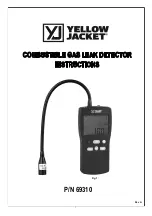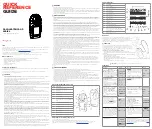
T R O U B L E $ H O O T I N G
• Max Sensitivity:
Treasure hunters may believe that they must run sensitivity on 10 (or Max), or they will lose
many inches. On the contrary, with the Coin$trike, setting sensitivity too high can lead to
accuracy problems.
Remember: Great effective depth can be achieved with lowered settings
.
• How Can ID’s Be Different?
The exact same item (such as a coin) will not always be the same number,
but it will remain favorable (“diggable”) in the positive ID range. Many fac-
tors, such as target position in the soil (coins on edge), coil position, ha-
los, nearby trash, and different depths contribute to the ID number generated.
•
Factory Preset Threshold:
The saved FP mode can be a good starting point for, as the manual says, “coins only” hunting.
However, some mineralized locations report stability problems or chatter with the Threshold
preset of 0. Again, start slow with say a -20 threshold for a more silent search. Once familiar
with the unit (and if soil permits), you can begin your climb back toward the 0 threshold level.
•
Is Averaging ON or OFF?
Be careful when attempting to activate A1. Hold the All Metal/Disc touch pad, and when A1
appears on the display, release it. Holding the touch pad too long will advance it to A0 again,
which deactivates this feature.
• Powerlines/ Outside Interference:
All detectors suffer in these areas, and the sensitive Coin$trike is no different. Once more,
adjusting the threshold to -20 or less makes these situations “huntable”. Sensitivity may also
be lowered if necessary.
• Salt Mode/Beaches:
Although many would assume the salt mode should always be ON (S1) at the beach, in mag-
netized or wet black sands of some beaches, better performance can be attained with Salt
OFF (S0) and a negative threshold setting. Salt mode OFF also seems to be more conducive
to small items of gold as well. For beaches with little or no black sand, set S1 before bal-
ancing and adjusting threshold & sensitivity. Tracking and Averaging ON can be helpful for
beach stability as well.
• Hot Rocks
:
Some parts of the country report black, hot rocks falling into “good” target ranges (exam-
ples: 02, 06, 12, & 51). But, just like iron that may read “good” on the initial swing, further
analysis of sweeps from different angles should cancel these hot rocks completely. Large,
and or, shallow hot rocks may “fool” you into recovery.
•
Area #51:
Seeing #51 show up often? Though this does appear on the unit in the possible “high, sil-
ver coin” range, as mentioned above, various “hot rocks” and other false signals may ID as
#51. Solution: only dig #51 if it repeats from other angles.
• Coil Cover Drawback:
Though recommended as protection for those who “scrub” the ground, use caution as the ul-
tra-sensitive Coin$trike can become very erratic when magnetized particles slip in between the
cover and coil. Beaches can be most troublesome, as black sands can build up inside quickly. TIP:
Coil cover users can fill the cracks with a type of silicone sealant to keep the mineralized soil out.
•
Light Leaks?
Users have questioned a trace of light from the side of the LCD while hunt-
ing at night using the back light. This is normal, and due to the clear
plastic panel of the Coin$trike. Your unit is still dust & splashproof.
FRL#8730018






















